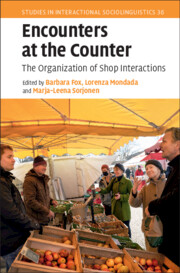Book contents
- Encounters at the Counter
- Studies in Interactional Sociolinguistics
- Encounters at the Counter
- Copyright page
- Contents
- Contributors
- 1 Encounters at the Counter
- 2 Approaching the Counter at the Supermarket
- 3 Customers’ Inquiries about Products
- 4 Offering a Taste in Gourmet Food Shops
- 5 Embodied Trajectories of Actions in Shop Encounters
- 6 Unpacking Packing
- 7 The Request-Return Sequence
- 8 Moving Money
- Appendix Transcription Conventions
- Index
- References
3 - Customers’ Inquiries about Products
Establishing Grounds for the Decision to Buy
Published online by Cambridge University Press: 19 January 2023
- Encounters at the Counter
- Studies in Interactional Sociolinguistics
- Encounters at the Counter
- Copyright page
- Contents
- Contributors
- 1 Encounters at the Counter
- 2 Approaching the Counter at the Supermarket
- 3 Customers’ Inquiries about Products
- 4 Offering a Taste in Gourmet Food Shops
- 5 Embodied Trajectories of Actions in Shop Encounters
- 6 Unpacking Packing
- 7 The Request-Return Sequence
- 8 Moving Money
- Appendix Transcription Conventions
- Index
- References
Summary
The chapter examines the formatting of initial turns by customers at the counter, before they decide and in order to select what to buy. On the basis of recordings in bakeries in Finland, France, and Switzerland, it is shown how customers may face a range of practical problems in making decisions as to what or whether to purchase, including seeing items that might look appealing but which they don’t recognize or for which they do not know the ingredients. Through the design of their questions, drawing on verbal, material, and embodied resources, customers make publicly available to the sellers their epistemic access to the products (e.g., they do not know enough about the item to formulate its identity with anything more than a demonstrative pronoun or demonstrative determiner plus ‘empty’ noun). With their answers sellers provide information that may be immediately useful for the customer in making their decision, or which may need further elaboration. The referential practices employed by both customers and sellers reveal features of items that are locally relevant for the practical purposes of buying, in particular sequential, material, and embodied locations in interaction.
Keywords
- Type
- Chapter
- Information
- Encounters at the CounterThe Organization of Shop Interactions, pp. 73 - 108Publisher: Cambridge University PressPrint publication year: 2023

